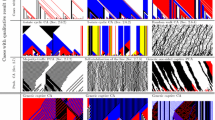Abstract
For some classes of cellular automata, we observe empirically a phenomenon of self-organization: starting from a random configuration, regular strips separated by defects appear in the space-time diagram. When there is no creation of defects, all defects have the same direction after some time. In this article, we propose to formalise this phenomenon. Starting from the notion of propagation of defect by a cellular automaton formalized in [Piv07b, Piv07a], we show that, when iterating the automaton on a random configuration, defects in one direction only remain asymptotically.
Access this chapter
Tax calculation will be finalised at checkout
Purchases are for personal use only
Preview
Unable to display preview. Download preview PDF.
Similar content being viewed by others
References
Boccara, N., Nasser, J., Roger, M.: Particlelike structures and their interactions in spatiotemporal patterns generated by one-dimensional deterministic cellular-automaton rules. Phys. Rev. A 44(2), 866–875 (1991)
Boyer, L., Poupet, V., Theyssier, G.: On the Complexity of Limit Sets of Cellular Automata Associated with Probability Measures. In: Královič, R., Urzyczyn, P. (eds.) MFCS 2006. LNCS, vol. 4162, pp. 190–201. Springer, Heidelberg (2006)
Eloranta, K.: The dynamics of defect ensembles in one-dimensional cellular automata. Journal of Statistical Physics 76, 1377–1398 (1994), doi:10.1007/BF02187067
Fisch, R.: The one-dimensional cyclic cellular automaton: A system with deterministic dynamics that emulates an interacting particle system with stochastic dynamics. Journal of Theoretical Probability 3, 311–338 (1990), doi:10.1007/BF01045164
Hanson, J.E., Crutchfield, J.P.: Computational mechanics of cellular automata: An example. Physica D: Nonlinear Phenomena 103(1-4), 169–189 (1997)
Hedlund, G.A.: Endomorphisms and automorphisms of the shift dynamical system. Theory of Computing Systems 3(4), 320–375 (1969)
Hurley, M.: Attractors in cellular automata. Ergodic Theory Dynam. Systems 10(1), 131–140 (1990)
Hurley, M.: Ergodic aspects of cellular automata. Ergodic Theory Dynam. Systems 10(4), 671–685 (1990)
Kůrka, P., Maass, A.: Limit sets of cellular automata associated to probability measures. Journal of Statistical Physics 100(5), 1031–1047 (2000)
Kůrka, P.: Cellular automata with vanishing particules. Fundamenta Informaticae 58, 1–19 (2003)
Pivato, M.: Defect particle kinematics in one-dimensional cellular automata. Theoretical Computer Science 377(1-3), 205–228 (2007)
Pivato, M.: Spectral domain boundaries in cellular automata. Fundamenta Informaticae 78(3), 417–447 (2007)
Theyssier, G.: Captive cellular automata. In: Fiala, J., Koubek, V., Kratochvíl, J. (eds.) MFCS 2004. LNCS, vol. 3153, pp. 427–438. Springer, Heidelberg (2004)
Walters, P.: An introduction to ergodic theory. Springer, Heidelberg (2000)
Wolfram, S.: Computation theory of cellular automata. Communications in Mathematical Physics 96(1), 15–57 (1984)
Author information
Authors and Affiliations
Editor information
Editors and Affiliations
Rights and permissions
Copyright information
© 2011 Springer-Verlag Berlin Heidelberg
About this paper
Cite this paper
Hellouin de Menibus, B., Sablik, M. (2011). Self-organization in Cellular Automata: A Particle-Based Approach. In: Mauri, G., Leporati, A. (eds) Developments in Language Theory. DLT 2011. Lecture Notes in Computer Science, vol 6795. Springer, Berlin, Heidelberg. https://doi.org/10.1007/978-3-642-22321-1_22
Download citation
DOI: https://doi.org/10.1007/978-3-642-22321-1_22
Publisher Name: Springer, Berlin, Heidelberg
Print ISBN: 978-3-642-22320-4
Online ISBN: 978-3-642-22321-1
eBook Packages: Computer ScienceComputer Science (R0)




